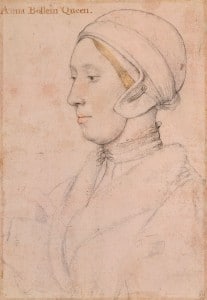
One of the rituals associated with childbirth was called “taking her chamber”. A Tudor woman usually “took to her chamber”, or went into confinement, four to six weeks before her due date.
Anne Boleyn took to her chamber on 26th August 1533, less than two weeks before Elizabeth was born. Elizabeth may have been premature, Anne may have miscalculated her dates, or she may have purposely entered confinement late to suggest that Elizabeth had been conceived legitimately.
Anne’s “taking her chamber” ceremony took place at Greenwich Palace. A heavily pregnant Queen Anne Boleyn attended a special mass at the palace’s Chapel Royal and then processed with her ladies to the Queen’s great chamber. There, the group enjoyed wine and spices before Anne’s lord chamberlain prayed that God would give the Queen a safe delivery. After the prayer, Anne and her ladies retired to her chamber, which, from that moment on, would be a male-free zone. The fifteenth century “Royalle Book” and the ordinances added to it by Lady Margaret Beaufort stipulated that the birthing chamber should: